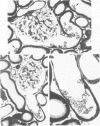Abstract
The topography of renal injury after ischemia-reflow was studied in intact rats by clamping the right renal artery for variable periods of time and examining the histologic appearance of the kidney in large 1-mu plastic sections. As reported by others, the straight portion of the proximal tubule (S3) was especially susceptible to ischemia-reflow injury. The pattern of focal necrosis produced in S3 by short (15-30-minute) and longer (45-60-minute) periods of arterial occlusion appeared related to gradients to oxygenation during reflow, in that more extensive injury was seen in areas remote from blood vessels, while perivascular tubules were protected. A similar pattern was seen in S1 and S2 after a longer period (45-60-minutes) of ischemia, which produced extensive but incomplete necrosis in these convoluted segments, with protected tubules lying within zones surrounding arcuate and interlobular arteries. The immediate postglomerular portion of S1, a tubular segment normally well supplied with oxygen, was an exception to this rule. Selective necrosis limited to this portion of the nephron appeared after only 15-30 minutes of ischemia, recalling the special sensitivity of S1 cells to inhibition of mitochondrial respiration. These results suggest that in different segments of the proximal tubule, injury after ischemia-reflow is determined not only by changes that occur during complete ischemia but also by the adequacy of oxygenation during the reflow period.
Full text
PDF






Images in this article
Selected References
These references are in PubMed. This may not be the complete list of references from this article.
- Alcorn D., Emslie K. R., Ross B. D., Ryan G. B., Tange J. D. Selective distal nephron damage during isolated kidney perfusion. Kidney Int. 1981 May;19(5):638–647. doi: 10.1038/ki.1981.63. [DOI] [PubMed] [Google Scholar]
- Arendshorst W. J., Finn W. F., Gottschalk C. W. Pathogenesis of acute renal failure following temporary renal ischemia in the rat. Circ Res. 1975 Nov;37(5):558–568. doi: 10.1161/01.res.37.5.558. [DOI] [PubMed] [Google Scholar]
- Brezis M., Rosen S., Silva P., Epstein F. H. Selective vulnerability of the medullary thick ascending limb to anoxia in the isolated perfused rat kidney. J Clin Invest. 1984 Jan;73(1):182–190. doi: 10.1172/JCI111189. [DOI] [PMC free article] [PubMed] [Google Scholar]
- Glaumann B., Glaumann H., Berezesky I. K., Trump B. F. Studies on the pathogenesis of ischemic cell injury. II. Morphological changes of the pars convoluta (P1 and P2) of the proximal tubule of the rat kidney made ischemic in vivo. Virchows Arch B Cell Pathol. 1975 Dec 19;19(4):281–302. [PubMed] [Google Scholar]
- Glaumann B., Trump B. F. Studies on the pathogenesis of ischemic cell injury. III. Morphological changes of the proximal pars recta tubules (P3) of the rat kidney made ischemic in vivo. Virchows Arch B Cell Pathol. 1975 Dec 19;19(4):303–323. [PubMed] [Google Scholar]
- Guder W. G., Ross B. D. Enzyme distribution along the nephron. Kidney Int. 1984 Aug;26(2):101–111. doi: 10.1038/ki.1984.143. [DOI] [PubMed] [Google Scholar]
- Leichtweiss H. P., Lübbers D. W., Weiss C., Baumgärtl H., Reschke W. The oxygen supply of the rat kidney: measurements of int4arenal pO2. Pflugers Arch. 1969 Jun 19;309(4):328–349. doi: 10.1007/BF00587756. [DOI] [PubMed] [Google Scholar]
- Reimer K. A., Ganote C. E., Jennings R. B. Alterations in renal cortex following ischemic injury. 3. Ultrastructure of proximal tubules after ischemia or autolysis. Lab Invest. 1972 Apr;26(4):347–363. [PubMed] [Google Scholar]
- STEWART R. D., SADEK S. E., SWANK J. D., DODD H. C. DIAGNOSIS OF TRICHLOROETHYLENE EXPOSURE AFTER DEATH. Arch Pathol. 1964 Jan;77:101–104. [PubMed] [Google Scholar]
- Venkatachalam M. A., Bernard D. B., Donohoe J. F., Levinsky N. G. Ischemic damage and repair in the rat proximal tubule: differences among the S1, S2, and S3 segments. Kidney Int. 1978 Jul;14(1):31–49. doi: 10.1038/ki.1978.87. [DOI] [PubMed] [Google Scholar]
- Vogt M. T., Farber E. On the molecular pathology of ischemic renal cell death. Reversible and irreversible cellular and mitochondrial metabolic alterations. Am J Pathol. 1968 Jul;53(1):1–26. [PMC free article] [PubMed] [Google Scholar]





